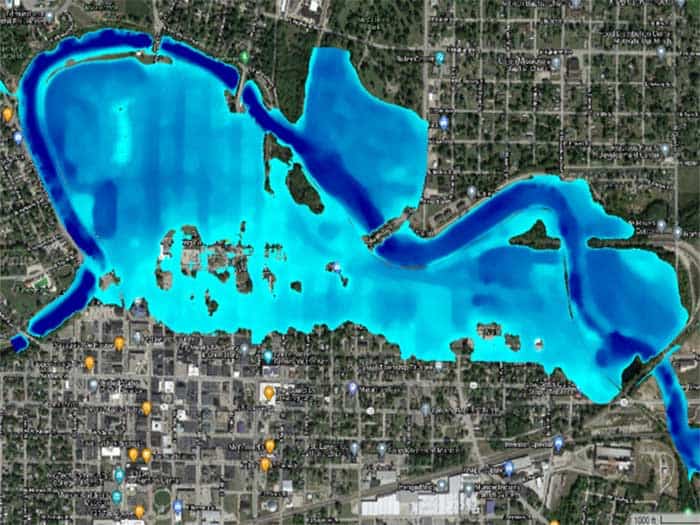


Hydrologic and hydraulic modeling software are critical for managing our nation’s surface waters. Quantitative models help local communities and environmental engineers better understand how surface waters change in response to development and pollution, and how to protect them. Surface water modeling software has been useful for solving large-scale watershed and local stormwater studies for over 50 years. Over time, these tools have evolved dramatically.
Early versions of Hydrology & Hydraulics (“H&H”) software were developed by the US Army Corps of Engineers Hydraulic Design Center (HDC). Examples are the early hydrologic modeling tool HEC-1 and the early open channel hydraulics tool, HEC-2. When a model was executed, results were in a simple tabular format, generally without notes about unusual results or troubleshooting tips.
These pieces of software were slow and cumbersome to use – generally, one needed a pad of paper and a pencil to make notes on printouts of the input code. Using these tools was a hassle, but – you knew every inch of the information entered. Back in the early days of these tools, specialty modeling firms flourished. Generally, “modelers” had master’s degrees supporting hydrologic or hydraulic study, which helped inform modeling.
Fast Forward to 2024
The picture of H&H modeling has changed dramatically. Understandably, the light-speed growth of software and computing power has enabled us to enter information and get results out of almost any model many times faster than the equivalent effort 40 years ago. Software user interfaces have become Windows-based, with 3D charts and output tools that give the whole story of a simulation with very easy access.
Moreover, an increasing number of public agencies are publishing their own HSPF-based long-term statistical hydrology simulation software. HSPF stands for “Hydrologic Simulation Program -FORTRAN,” originally developed by the EPA as a flow/duration model. It gives statistical returns of rainfall/runoff events over a period of years. A sophisticated but cumbersome to use platform, many agencies have incorporated the HSPF engine into a locally focused “Black Box Model,” which reduces user input down to the general characteristics of tributary areas and then directly produces a necessary BMP (pond, swale, etc.) footprint.
Legacy to HydroCAD
The legacy USACE tools mentioned previously evolved from HEC-1 and HEC-2 to HEC-HMS and HEC-RAS in their current versions. Both current models feature advanced data input, computation, and output modes. HEC-RAS, in particular, has evolved to perform dynamic flow simulations, GIS-based mapping, and 2-D flow calculation (not just straight down the channel, but also coming in/out of the channel from all directions).
Some newer, practicality-based tools, such as HydroCAD, enable the general civil engineer to perform H&H calculations to a significant level of detail for single-event storms. Additionally, today’s younger engineers have developed an ability to use new software that exceeds any previous generation.
Field Experience and Expertise Matters
Challenges can arise when adeptness at locating and entering data exceeds the user’s experience in hydrologic or hydraulic studies. Balancing this knowledge is crucial since both are essential for accurate water resources study (environmental, stormwater, and work related to climate change).
The aspect of current progress that gives one pause is how easy it has become to get results. Today’s users are adept at running simulations and getting results. However, sometimes these results are wrong or at least should raise questions.
Unfortunately, a novice user can get results that may look “fine” to them but odd to an experienced water resource engineer. If not carefully reviewed for engineering judgment, the less experienced user could inadvertently issue plans or study results with costly errors—This is a critical reason for a seasoned modeling professional’s review for quality assurance.
H&H software is more accessible and rapid than ever before but offers new challenges in ensuring those using, interpreting, and reviewing output have sufficient background in the subject matter. Moving forward, modelers who receive assistance with the “buttons and levers,” as well as a review of results by an experienced water resources professional, will learn to start thinking critically about their analysis results more quickly.
More formally, a project-specific QC process geared toward the review of applied hydraulics in H&H modeling helps maintain a firm’s quality of modeling performance and documentation
Hydrologic and Hydraulic Modeling Resources:

He successfully delivered several capital programs as a public works project manager for the City of Oregon City, OR. He has also assisted public agencies as an owner’s engineer. His combination of public and private experience helps foster collaboration on challenging design and permitting efforts.
Jon has delivered dozens of successful civil and water resource projects in the Pacific Northwest, California, and Alaska. Projects include site civil infrastructure, private and public utility design, hydrologic and hydraulic modeling studies, and design and accreditation of flood control systems. You can reach Jonathan or any of our Stormwater experts at or on LinkedIn.